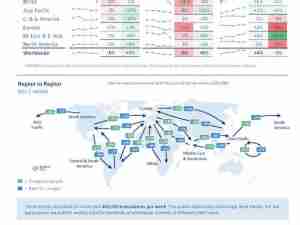India's ambitious plans to expand its aviation sector have made little headway because its existing airports are in such an anachronistic state that, along with the incomprehensible and meaningless layers of bureaucracy, they are actually becoming an obstacle to the future growth needed to catapult the country into the league of international players. Besides being an eyesore, the country's airports are already bursting at the seams and may not be able to cope with the pressures of future growth expected in both air passenger and cargo traffic.
The urgency for developing India's airports was underscored at a recent conference, "India's Infrastructure Challenges and Opportunities," held in Washington DC. At the conference the visiting Indian civil aviation minister Praful Patel announced that the airport projects of two hi-tech Indian cities, Bangalore and Hyderabad, were progressing according to schedule, and would be completed by the year 2008.
India's two busiest cities, Mumbai and Delhi, badly need bigger and more modern airports to cope with the onslaught of the growing passenger and cargo traffic. The Indian business community around the world has been criticizing the "utter neglect" on the part of Indian politicians who have been talking ad nauseam for years about modernizing and expanding India's airports, particularly in metropolitan cities, but have so far done very little or nothing at all to alleviate the congestion. The decision-making process in India is a long and arduous journey, often ending in stalemate because of vested interests of various politicians or bureaucrats.
The Indian Government, according to Patel, plans to develop the airports of Kolkata in the East and Chennai in the South. He added that 35 non-metro airports had been identified for partnerships with public and private enterprises. The minister also averred that these airports, when completed by 2009, would ensure 100% compliance with international airport standards.
Aware of the frustration over India's appalling infrastructure deficiencies which have constricted air-passenger and cargo traffic, the aviation minister admitted that the country had lost out in the race for creating a "hub for India within India." He even took jibes at India's aviation sector when he said, "Singapore is the hub for India in the East and Dubai, probably, is the hub for India in the West." Nevertheless, he reinforced the Indian Government's determination to redress those shortcomings, "in the shortest possible time," hoping that US support for this objective would be forthcoming.
Patel spoke of the "phenomenal investment opportunities" in India's airport development sector and pointed out that for India's one billion plus population, the country had less than 200 commercial aircraft, compared to over 7,000 planes for some 300 million people in the United States. There is also "great potential" for transporting cargo by air within India where today cargo is moved mainly by road or rail. Civil aviation is among the fastest growing sectors in India, and will attract the highest investment in the coming five years. The potential, Patel said, is in the region of $ 30 to $ 40 billion.
US transportation secretary Norman Y. Mineta, who together with Patel signed the US-India Open Skies Agreement in April, claimed that the bilateral open-skies treaty was already reaping dividends for airlines on both sides. He pointed out, "It is expanding existing services, and introducing new services to meet the needs of the fast-developing US-India aviation market." US experts at the conference said that they envisaged strong growth in cargo traffic as air traffic between the two countries continues to rise.
However, Indian airports woefully lack facilities for transport of cargo not only to international destinations, but also within India itself. The lethargic bureaucracy is viewed by the cargo trade as another major hurdle because many of the procedures and paperwork followed have become outdated and irrelevant, and






